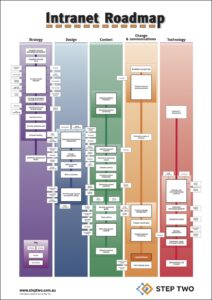
Welcoming shop owner from Shutterstock
Filed under: Articles, Intranets
Organisations often envisage their intranets as integral to the way staff do their jobs. Staff are expected to visit the intranet daily.
While this is an admirable goal, it doesn’t necessarily match the reality of most intranets today. There are clear reasons for staff to use the intranet, but these are not always well understood.
In practice, there are two key reasons for a staff member to come to the intranet: to find a specific piece of information, or to complete a specific task.
Recognising this, intranet designers can ensure that intranet resources are targeted in ways that will have the greatest impact.
This briefing explores these two key reasons for intranet usage, and discusses their impact on intranet strategies and approaches.
Two reasons for visiting the intranet
There are two fundamental reasons why staff visit the corporate intranet:
- Finding a specific piece of information: The staff member is looking for a specific fact, detail or figure (such as how much leave they have left to take this year).
- Completing a specific task: The staff member has a particular activity to do, which the intranet can help with (such as booking travel).
Note that in both cases, the staff member is not looking for the HR manual, a procedure, or some other general resource. Instead, they are seeking something very specific to meet an immediate need.
Secondary reasons
There are other reasons why staff use an intranet. They may want to keep up with what is happening in the organisation (news), or learn about how the organisation works (new starters).
While these are legitimate needs that must be met, they fall far behind the two main goals outlined above.
Intranet usage will be increased if it’s the default browser home page, but usage may not extend into the rest of the site.
In and out
The most immediate consequence of the reasons staff visit the intranet is that their usage is very ‘in and out’.
When they have a need they open the intranet, navigate or search until they have what they want, and then close the intranet.
Staff don’t live in the intranet, and their day-to-day work lies in the real world. The intranet is therefore only used when needed, and ignored the rest of the time.
Focused usage
When using the intranet in this matter, staff are very focused on finding the specific item, or completing the current task. Any other information will be seen as a distraction and ignored (this is known as ‘inattentional blindness’), until the primary activity is completed.
This is challenging for intranet teams, as it means that while a frequently used feature will be very helpful to staff, it may not increase usage of the rest of the site. (For example, the staff directory is often a ‘killer app’, but the rest of the site may still be rarely used.)
Using other sources
In many cases, staff will try other sources of information first, before coming to the intranet. This includes using the piece of paper pinned to their cubicle wall, asking the person sitting next to them or picking up the phone.
The intranet is therefore a resource of ‘last resort’ in most cases. It may only be used when something is hard to find or uncommon.
Making the intranet useful
The corollary of all of these observations is this: if you want the intranet to be used more, make it more useful. The better the intranet helps staff find specific pieces of information or complete specific tasks, the more extensively it will be used. (As long as staff know that the intranet provides these capabilities.)
Only then will the intranet become a more effective news channel, as well as delivering other benefits (such as building corporate culture).
(For a practical approach to intranet planning that simultaneously delivers additional intranet functionality, see the 6×2 methodology for Intranets.)





